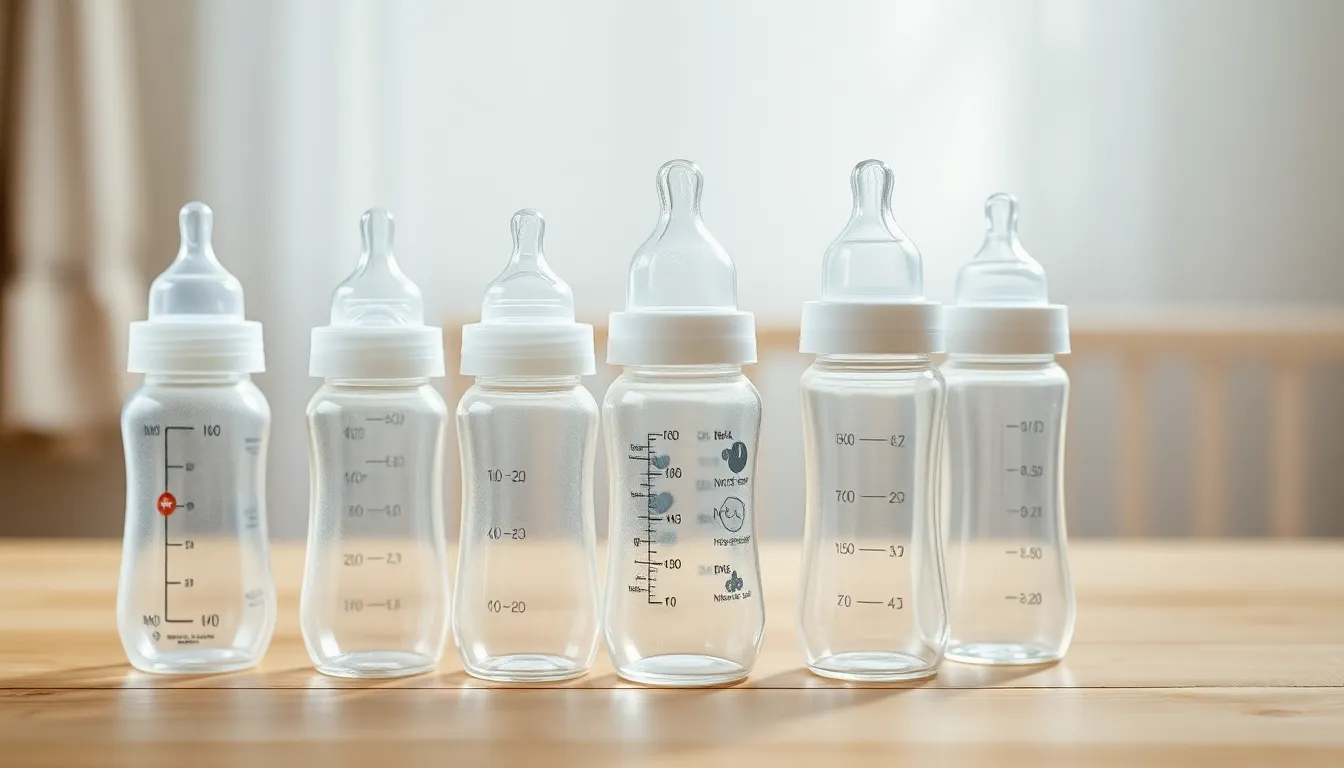Choosing the right bottle for a newborn might seem as daunting as solving a Rubik’s Cube blindfolded. With a dizzying array of options, it’s easy to feel overwhelmed. But fear not! Finding the perfect bottle isn’t just about looks; it’s about ensuring a happy feeding experience for both baby and parent.
Table of Contents
ToggleOverview of Newborn Bottles
Choosing the right bottle for newborns involves understanding several key features. Various designs cater to infants’ unique needs and preferences. Soft nipples mimic breastfeeding, easing the transition between bottle and breast. Durable materials like BPA-free plastic or glass ensure safety while maintaining quality.
Nipple flow rates differ, with slow flow often recommended for newborns. This feature helps prevent overfeeding and reduces the risk of choking. Curved shapes allow for a comfortable grip, making feeding easier for parents. Some bottles even offer anti-colic designs to minimize gas and fussiness during feedings.
Parents should consider bottle sizes as well. Smaller bottles are ideal for newborns since they consume less milk in each feeding. On average, bottles hold between 4 to 8 ounces, suiting newborn needs. Easily removable parts facilitate cleaning, vital for maintaining hygiene.
Regarding compatibility, some bottles work with breast pumps, ensuring a seamless transition for those who pump milk. Finding the right bottle involves testing different types, since preferences vary between infants. Many brands provide trial kits that allow parents to explore multiple options before committing.
Ultimately, selecting the best bottle for a newborn requires careful consideration of features, materials, and infant comfort. Recognizing the significance of these choices affects the entire feeding experience. Having multiple bottles on hand supports varied feeding situations, enhancing convenience and flexibility for parents.
Key Features to Consider

Choosing the right bottle for a newborn involves several important features to ensure comfort and convenience during feeding.
Nipple Shape and Flow Rate
Nipples come in various shapes, including wide, breast-like designs that help mimic natural breastfeeding. Many parents find that such shapes encourage better latching. Flow rates also play a crucial role; slow flow nipples suit newborns as they help regulate intake, minimizing risks of overfeeding or choking. Some brands offer adjustable flow rates, enabling tailored feeding experiences as the baby grows. Consider testing different styles and flow options to find what works best for the newborn.
Bottle Material and Design
Plastic and glass materials are common for baby bottles, each with distinct advantages. BPA-free plastic is lightweight and shatterproof, while glass bottles provide durability and are easy to clean. Design is equally vital; ergonomic shapes promote comfortable handling for parents. Some bottles feature anti-colic designs, which minimize gas buildup, enhancing overall feeding satisfaction. Choosing the right shape and material not only aids in feeding but also supports the newborn’s comfort during bottle use.
Top Recommendations for Best Bottles for Newborns
Choosing the right bottle greatly impacts a newborn’s feeding experience. Here are some top recommendations based on essential features and benefits.
Bottle A: Features and Benefits
Bottle A boasts a soft silicone nipple designed to mimic the natural feel of breastfeeding. This feature encourages an easier latch for newborns adjusting to bottle feeding. Made from BPA-free materials, it ensures safety while remaining lightweight for easy handling. Venting systems included in the design minimize colic by reducing air intake during feedings. The bottle’s wide neck allows for effortless cleaning, making it convenient for parents. Available in multiple sizes, it can accommodate growing infants.
Bottle B: Features and Benefits
Bottle B stands out with its unique shape that promotes an ergonomic grip for parents. This bottle uses a flow rate suited for newborns to prevent choking and overfeeding. The anti-colic design incorporates a built-in vent, allowing for a smoother feeding experience with less fussiness. Compatible with various breast pumps, it provides seamless transitions for those juggling breastfeeding and bottle feeding. Cleaning Bottle B is simple, thanks to its dishwasher-safe components, ensuring hygiene without hassle.
Bottle C: Features and Benefits
Bottle C features a breast-like nipple that adjusts to a baby’s sucking reflex, which aids in better acceptance. Crafted from high-quality glass, this option offers durability while being easy to sterilize. Its sleek design fits comfortably in hands, promoting ease during feeding sessions. Anti-colic technology is embedded in its design, significantly reducing gas and discomfort. Additionally, multiple ounce capacities allow parents to choose the right size for different feeding needs.
Tips for Choosing the Right Bottle
Selecting the right bottle for a newborn involves understanding both the baby’s needs and practical aspects of bottle care.
Consider Your Baby’s Preferences
Baby’s comfort plays a significant role in bottle selection. Observing how a newborn responds to different nipple shapes can provide insight into their preferences. A wide, soft nipple often promotes better latching, which mimics the breastfeeding experience. Some babies may prefer a faster flow if they demonstrate frustration during feeding. Ensuring that the bottle design aligns with the baby’s natural sucking reflex can also enhance the feeding process. Trying various options allows parents to determine what best suits their little one’s unique style.
Ease of Cleaning and Maintenance
Simplicity in cleaning is essential for bottle maintenance. Bottles with fewer parts tend to make cleaning faster and more efficient. Opting for dishwasher-safe materials can reduce manual washing time. Glass bottles often rank high for ease of cleaning, as they resist staining and odor retention. BPA-free plastic offers similar advantages with added durability. Consider bottles designed with wide openings, as they provide better access for scrubbing. Regular cleaning helps maintain hygiene, crucial for a newborn’s health, so prioritizing this aspect simplifies daily routines.
Choosing the right bottle for a newborn is a significant decision that can greatly impact feeding experiences. With various options available parents can find bottles that suit their baby’s needs while ensuring comfort and ease of use.
Factors like nipple shape flow rate and material play crucial roles in this selection process. By considering these elements parents can enhance feeding sessions and minimize issues like gas and fussiness.
Ultimately having a few different bottles on hand allows for flexibility and helps parents discover what works best for their little one. Prioritizing quality and functionality will lead to a more satisfying feeding journey for both baby and parent.




